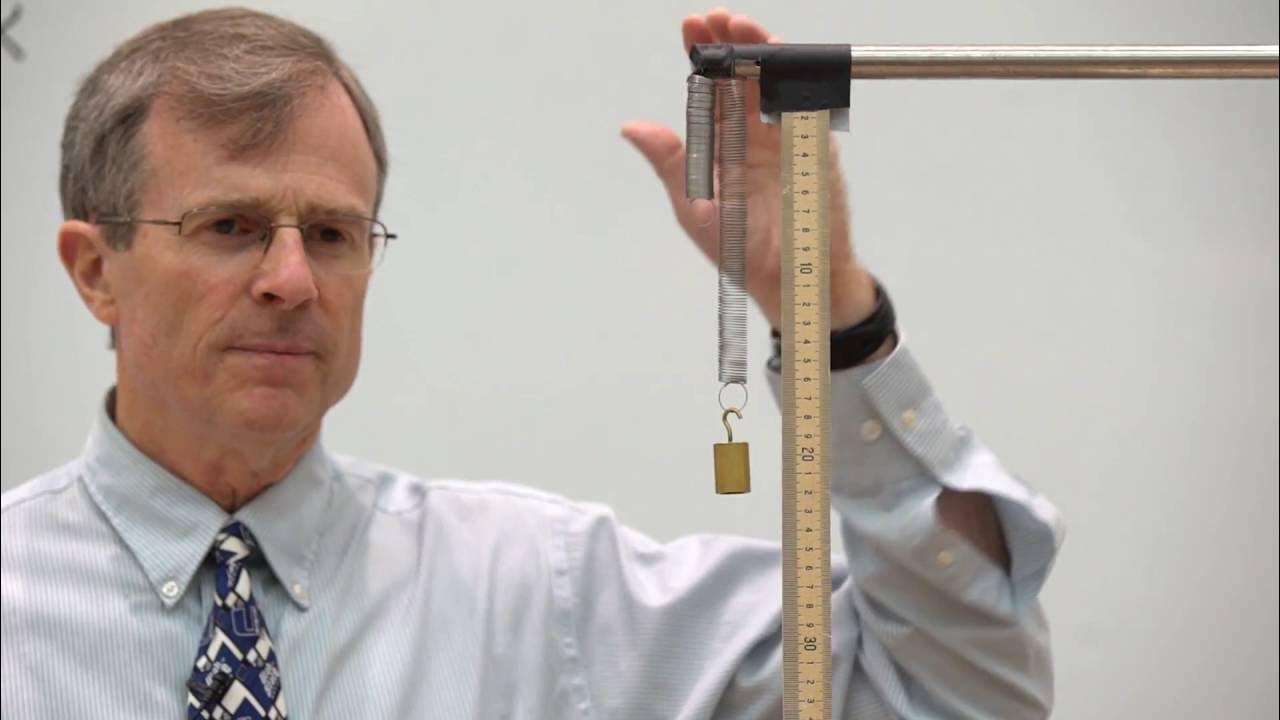Fisika SMA - Gerak Harmonik (1) - Pengenalan Gerak Harmonik Sederhana, Periode dan Frekuensi (I)
Summary
TLDRIn this educational video, the presenter explains the concept of Simple Harmonic Motion (SHM), focusing on its basic principles such as oscillation, equilibrium, amplitude, and the relationship between period and frequency. The video covers the oscillatory behavior of systems like pendulums and mass-spring systems, explaining key terms like displacement, maximum displacement, restoring force, and spring constant. The presenter also walks through various formulas related to SHM, including those for period, frequency, and angular frequency, with practical examples to help viewers understand the theory behind SHM. The video is intended to assist students in mastering these concepts in physics.
Takeaways
- 😀 Simple harmonic motion (SHM) is a type of oscillatory motion where an object moves back and forth through a central equilibrium point.
- 😀 Oscillation refers to the back-and-forth movement of an object through an equilibrium position, and it can be observed in everyday items like pendulums and springs.
- 😀 The 'equilibrium point' is the position where an object is at rest and not moving, and it’s a crucial concept in SHM systems such as a spring-mass system or a pendulum.
- 😀 Displacement in SHM refers to how far an object is from its equilibrium point during oscillation, denoted by 'x' or 'y' depending on the direction of motion.
- 😀 The maximum displacement, known as amplitude, represents the farthest point the object reaches from the equilibrium position.
- 😀 The period (T) of SHM is the time it takes for an object to complete one full oscillation, and it’s related to the mass and spring constant in a spring-mass system.
- 😀 Frequency (f) is the number of complete oscillations per unit of time, and it is the reciprocal of the period (f = 1/T).
- 😀 The angular frequency (ω) describes how quickly an object oscillates and is related to both the period and the frequency, with ω = √(k/m) for spring-mass systems.
- 😀 In SHM, the restoring force is what drives the object back toward its equilibrium point, and it’s typically proportional to the displacement.
- 😀 In practical problems, such as spring oscillations or pendulum motions, the period can be calculated using specific formulas that take into account the object's mass, the spring constant, and the length of the pendulum.
Q & A
What is Simple Harmonic Motion (SHM)?
-Simple Harmonic Motion (SHM) is a type of oscillatory motion where an object moves back and forth around a central equilibrium position. This motion is periodic and can be described in terms of displacement, velocity, and acceleration.
What is the equilibrium position in SHM?
-The equilibrium position is the point where the object is at rest and has no net force acting on it. In the case of a spring-mass system, the equilibrium position is when the spring is neither stretched nor compressed.
What is amplitude in SHM?
-Amplitude is the maximum displacement of an object from its equilibrium position during oscillation. It is the greatest distance the object travels from the central point, and it is measured in meters (m) or centimeters (cm).
What does the term 'displacement' refer to in SHM?
-Displacement in SHM refers to the distance an object has moved from its equilibrium position, which can be either positive (above the equilibrium) or negative (below the equilibrium).
What is the period of SHM?
-The period of SHM is the time it takes for an object to complete one full oscillation, returning to its original position. It is denoted by 'T' and is measured in seconds.
How is the frequency of SHM related to the period?
-Frequency (f) is the number of oscillations that occur per unit of time. It is the reciprocal of the period, with the formula f = 1/T.
What is the restoring force in SHM?
-The restoring force in SHM is the force that acts on the object to bring it back to the equilibrium position. For a spring-mass system, this force is proportional to the displacement from the equilibrium and is given by Hooke's Law: F = -kx, where 'k' is the spring constant and 'x' is the displacement.
How do you calculate the angular frequency (ω) of a spring-mass system?
-The angular frequency (ω) of a spring-mass system is calculated using the formula ω = √(k/m), where 'k' is the spring constant and 'm' is the mass of the object attached to the spring.
What is the relationship between angular frequency (ω) and frequency (f)?
-Angular frequency (ω) is related to frequency (f) by the formula ω = 2πf, where 'f' is the frequency of oscillation.
How does the length of a pendulum affect its period?
-For a simple pendulum, the period is affected by the length of the string (l) and the acceleration due to gravity (g). The formula for the period is T = 2π√(l/g), meaning the period increases as the length of the pendulum increases.
Outlines

This section is available to paid users only. Please upgrade to access this part.
Upgrade NowMindmap

This section is available to paid users only. Please upgrade to access this part.
Upgrade NowKeywords

This section is available to paid users only. Please upgrade to access this part.
Upgrade NowHighlights

This section is available to paid users only. Please upgrade to access this part.
Upgrade NowTranscripts

This section is available to paid users only. Please upgrade to access this part.
Upgrade NowBrowse More Related Video

Dao động điều hòa: Chu kì. Tần số. Tần số góc. Vận tốc và gia tốc của vật dao động điều hòa

Gerak Harmonik Sederhana • Part 1: Konsep & Persamaan Simpangan Getaran Harmonis

GERAK HARMONIK SEDERHANA: MATERI FISIKA KELAS XI

Pengantar Materi Getaran dan Gelombang pada Mata Kuliah Fisika Dasar ITK 2020/2021

Oscillations Demo: Mass Spring System

Demonstrating What Changes the Period of Simple Harmonic Motion(SHM)
5.0 / 5 (0 votes)